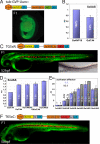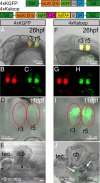Optimized Gal4 genetics for permanent gene expression mapping in zebrafish
- PMID: 19628697
- PMCID: PMC2726396
- DOI: 10.1073/pnas.0903060106
Optimized Gal4 genetics for permanent gene expression mapping in zebrafish
Abstract
Combinatorial genetics for conditional transgene activation allows studying gene function with temporal and tissue specific control like the Gal4-UAS system, which has enabled sophisticated genetic studies in Drosophila. Recently this system was adapted for zebrafish and promising applications have been introduced. Here, we report a systematic optimization of zebrafish Gal4-UAS genetics by establishing an optimized Gal4-activator (KalTA4). We provide quantitative data for KalTA4-mediated transgene activation in dependence of UAS copy numbers to allow for studying dosage effects of transgene expression. Employing a Tol2 transposon-mediated KalTA4 enhancer trap screen biased for central nervous system expression, we present a collection of self-reporting red fluorescent KalTA4 activator strains. These strains reliably transactivate UAS-dependent transgenes and can be rendered homozygous. Furthermore, we have characterized the transactivation kinetics of tissue-specific KalTA4 activation, which led to the development of a self-maintaining effector strain "Kaloop." This strain relates transient KalTA4 expression during embryogenesis via a KalTA4-mediated autoregulatory mechanism to live adult structures. We demonstrate its use by showing that the secondary octaval nucleus in the adult hindbrain is likely derived from egr2b-expressing cells in rhombomere 5 during stages of early embryogenesis. These data demonstrate prolonged and maintained expression by Kalooping, a technique that can be used for permanent spatiotemporal genetic fate mapping and targeted transgene expression in zebrafish.
Conflict of interest statement
The authors declare no conflict of interest.
Figures




Similar articles
-
Intersectional Gene Expression in Zebrafish Using the Split KalTA4 System.Zebrafish. 2015 Dec;12(6):377-86. doi: 10.1089/zeb.2015.1086. Epub 2015 Oct 20. Zebrafish. 2015. PMID: 26485616 Free PMC article.
-
Targeting olfactory bulb neurons using combined in vivo electroporation and Gal4-based enhancer trap zebrafish lines.J Vis Exp. 2011 Aug 15;(54):2964. doi: 10.3791/2964. J Vis Exp. 2011. PMID: 21860381 Free PMC article.
-
Gal4 Driver Transgenic Zebrafish: Powerful Tools to Study Developmental Biology, Organogenesis, and Neuroscience.Adv Genet. 2016;95:65-87. doi: 10.1016/bs.adgen.2016.04.002. Epub 2016 Jun 13. Adv Genet. 2016. PMID: 27503354 Review.
-
Optimization of the Gal4/UAS transgenic tools in zebrafish.Appl Microbiol Biotechnol. 2019 Feb;103(4):1789-1799. doi: 10.1007/s00253-018-09591-0. Epub 2019 Jan 6. Appl Microbiol Biotechnol. 2019. PMID: 30613898
-
Transgenic fish systems and their application in ecotoxicology.Crit Rev Toxicol. 2015 Feb;45(2):124-41. doi: 10.3109/10408444.2014.965805. Epub 2014 Nov 14. Crit Rev Toxicol. 2015. PMID: 25394772 Review.
Cited by
-
Development of the bi-partite Gal4-UAS system in the African malaria mosquito, Anopheles gambiae.PLoS One. 2012;7(2):e31552. doi: 10.1371/journal.pone.0031552. Epub 2012 Feb 13. PLoS One. 2012. PMID: 22348104 Free PMC article.
-
Silencer-delimited transgenesis: NRSE/RE1 sequences promote neural-specific transgene expression in a NRSF/REST-dependent manner.BMC Biol. 2012 Nov 30;10:93. doi: 10.1186/1741-7007-10-93. BMC Biol. 2012. PMID: 23198762 Free PMC article.
-
Plxnd1-mediated mechanosensing of blood flow controls the caliber of the Dorsal Aorta via the transcription factor Klf2.bioRxiv [Preprint]. 2024 Jan 25:2024.01.24.576555. doi: 10.1101/2024.01.24.576555. bioRxiv. 2024. PMID: 38328196 Free PMC article. Preprint.
-
Negative cell cycle regulation by calcineurin is necessary for proper beta cell regeneration in zebrafish.Elife. 2024 Oct 9;12:RP88813. doi: 10.7554/eLife.88813. Elife. 2024. PMID: 39383064 Free PMC article.
-
The centrosome neither persistently leads migration nor determines the site of axonogenesis in migrating neurons in vivo.J Cell Biol. 2010 Nov 15;191(4):875-90. doi: 10.1083/jcb.201004154. Epub 2010 Nov 8. J Cell Biol. 2010. PMID: 21059852 Free PMC article.
References
-
- Scheer N, Campos-Ortega JA. Use of the Gal4-UAS technique for targeted gene expression in the zebrafish. Mech Dev. 1999;80:153–158. - PubMed
-
- Deiters A, Yoder JA. Conditional transgene and gene targeting methodologies in zebrafish. Zebrafish. 2006;3:415–429. - PubMed
-
- Scott EK, et al. Targeting neural circuitry in zebrafish using GAL4 enhancer trapping. Nat Methods. 2007;4:323–326. - PubMed
Publication types
MeSH terms
Substances
LinkOut - more resources
Full Text Sources
Other Literature Sources
Molecular Biology Databases

